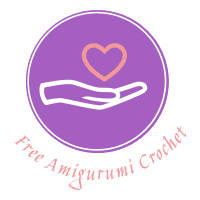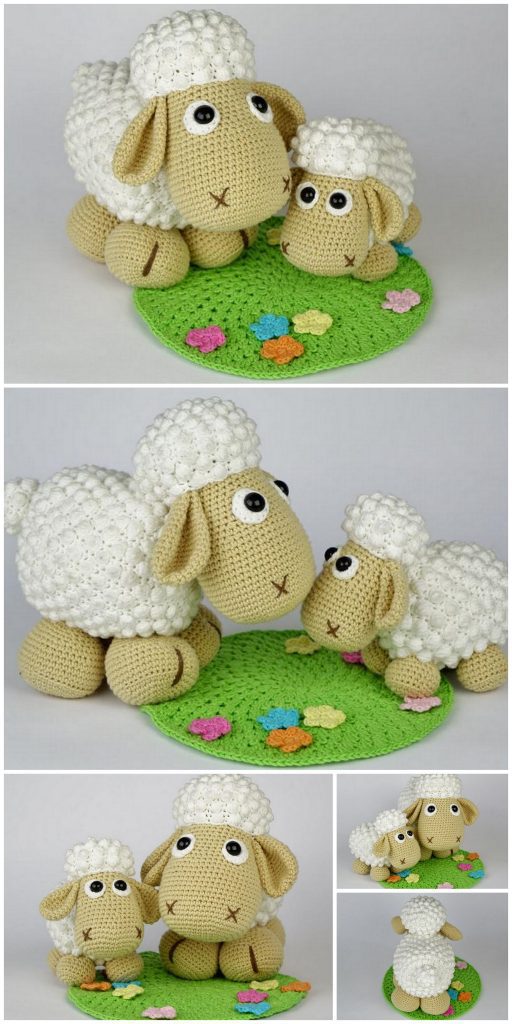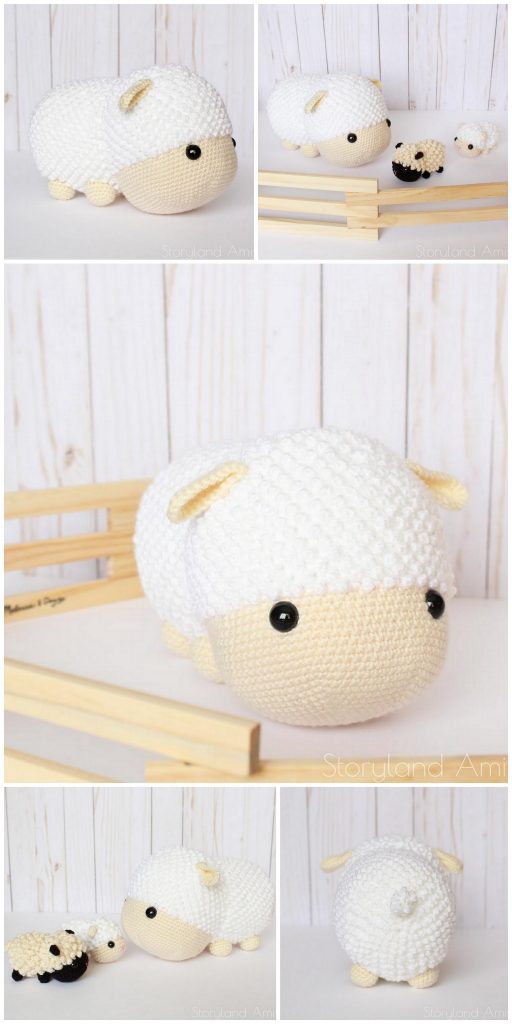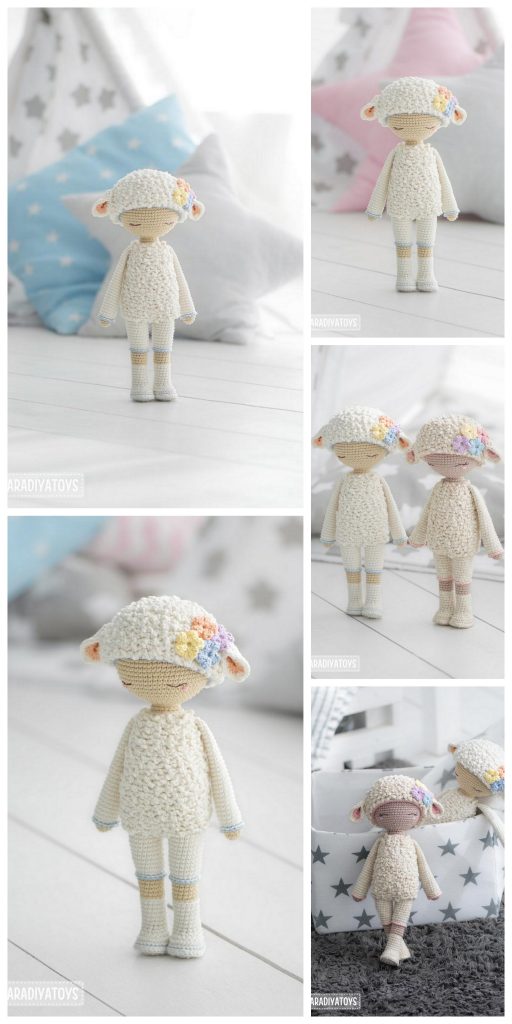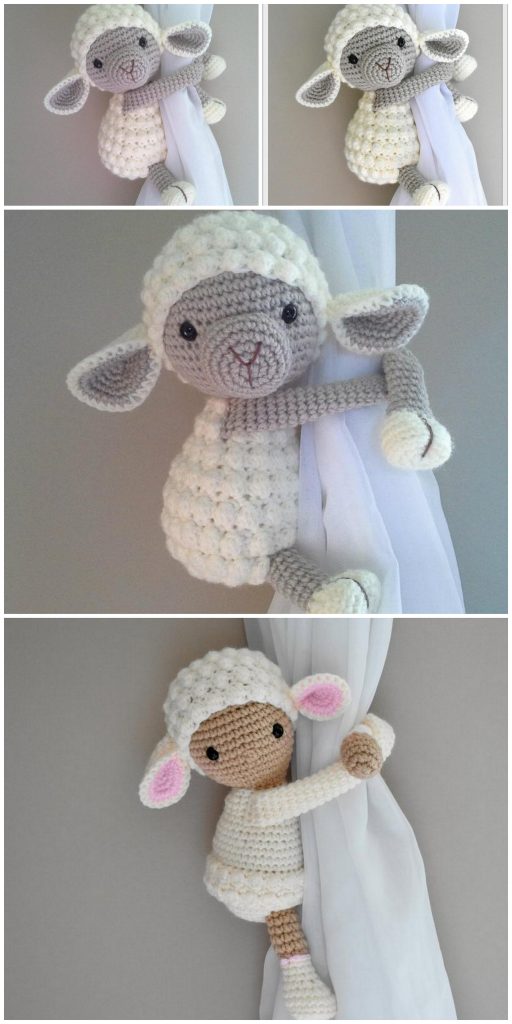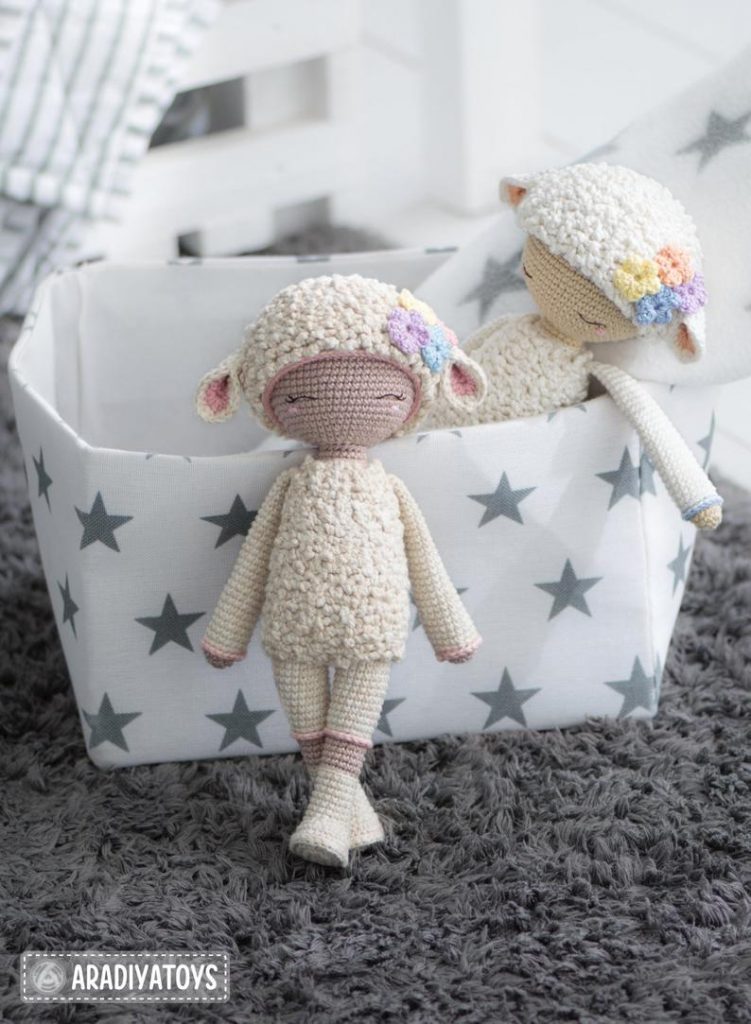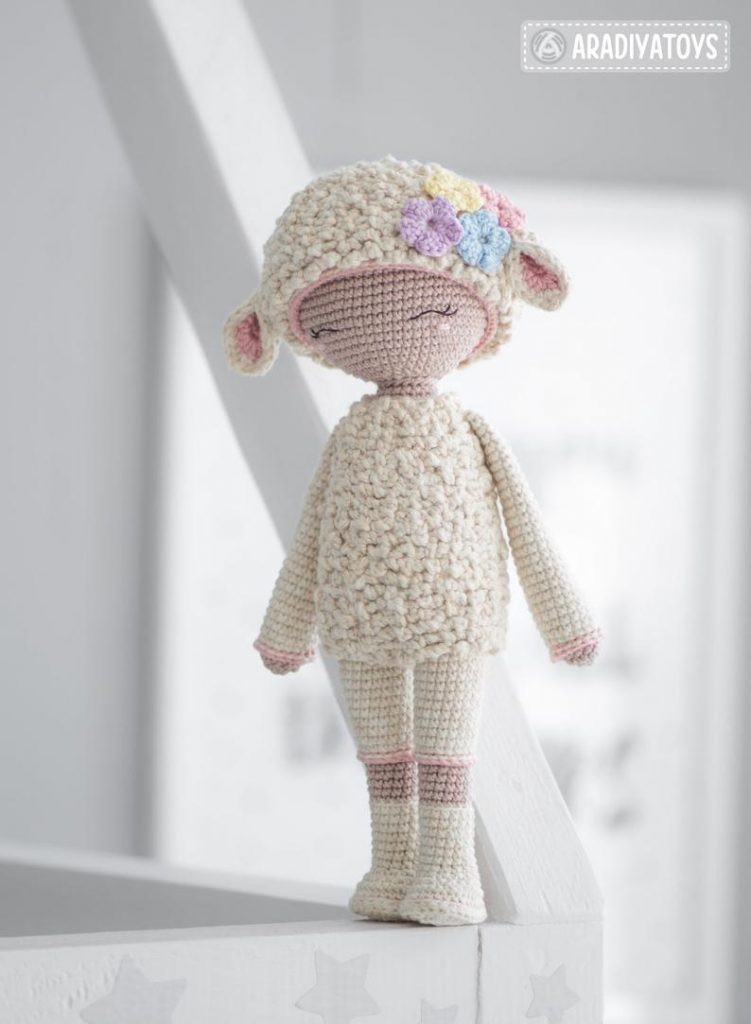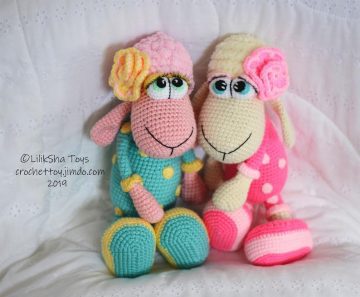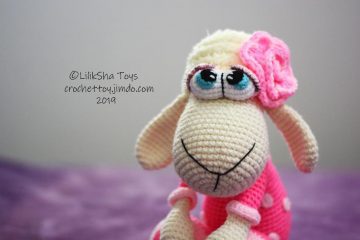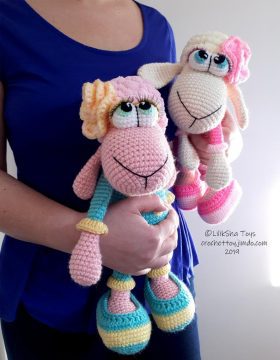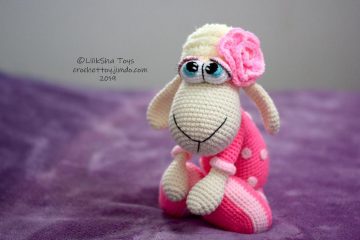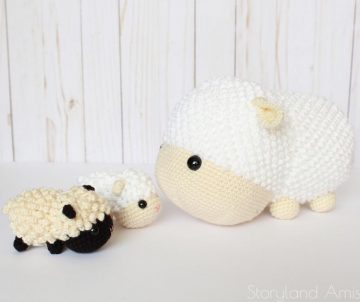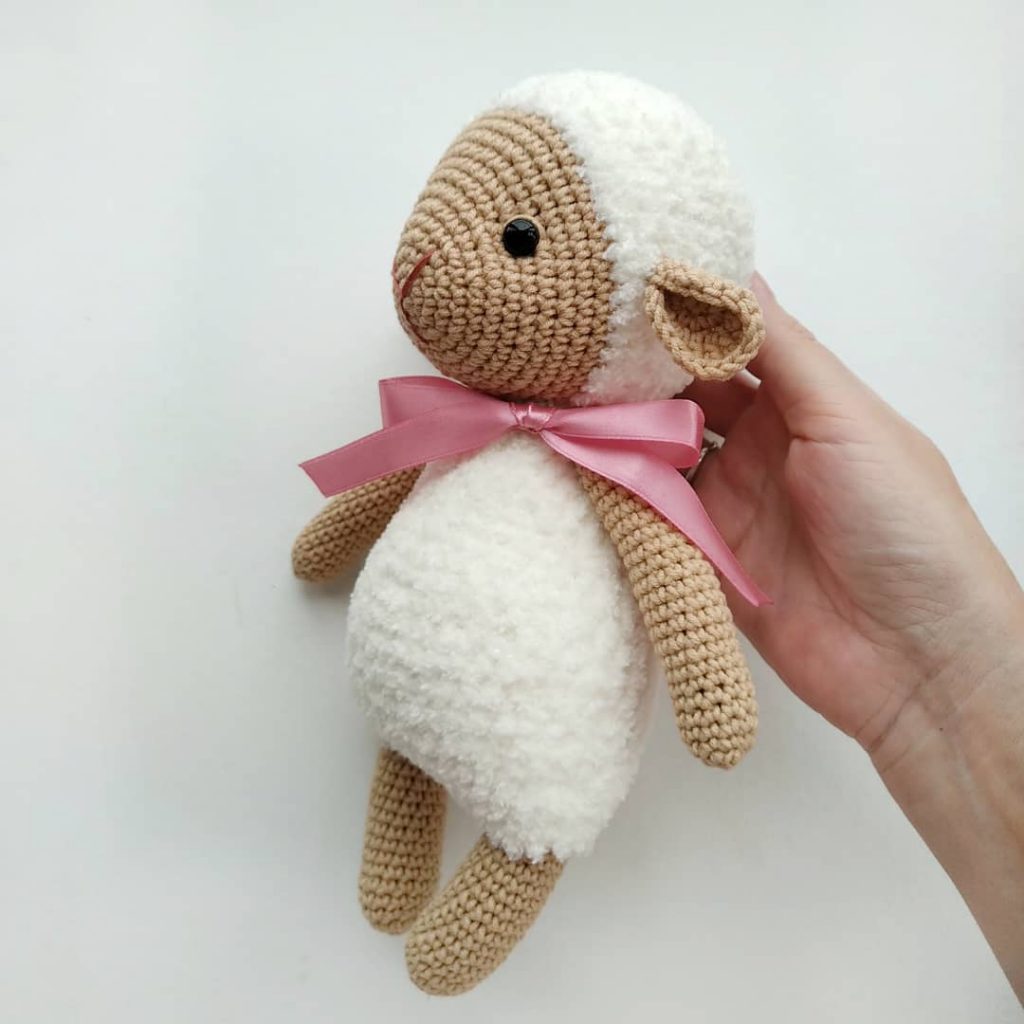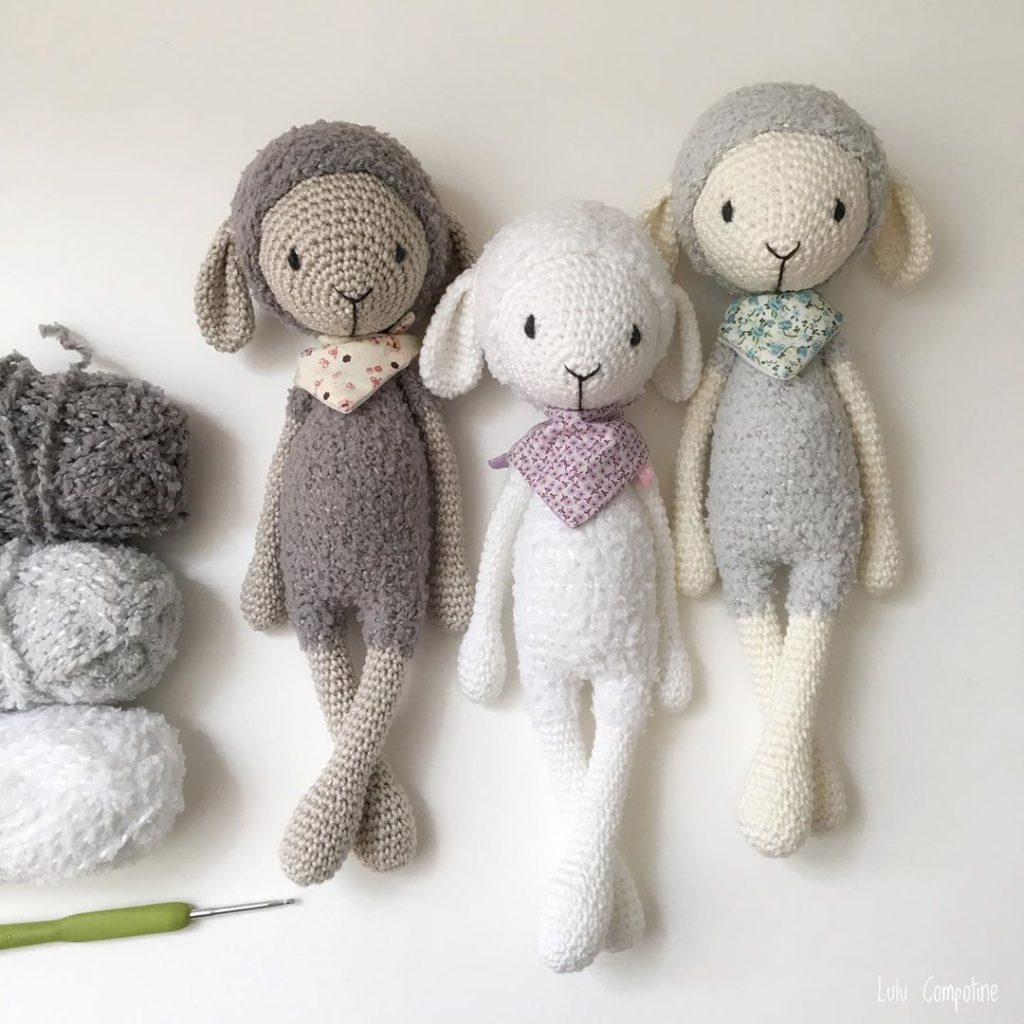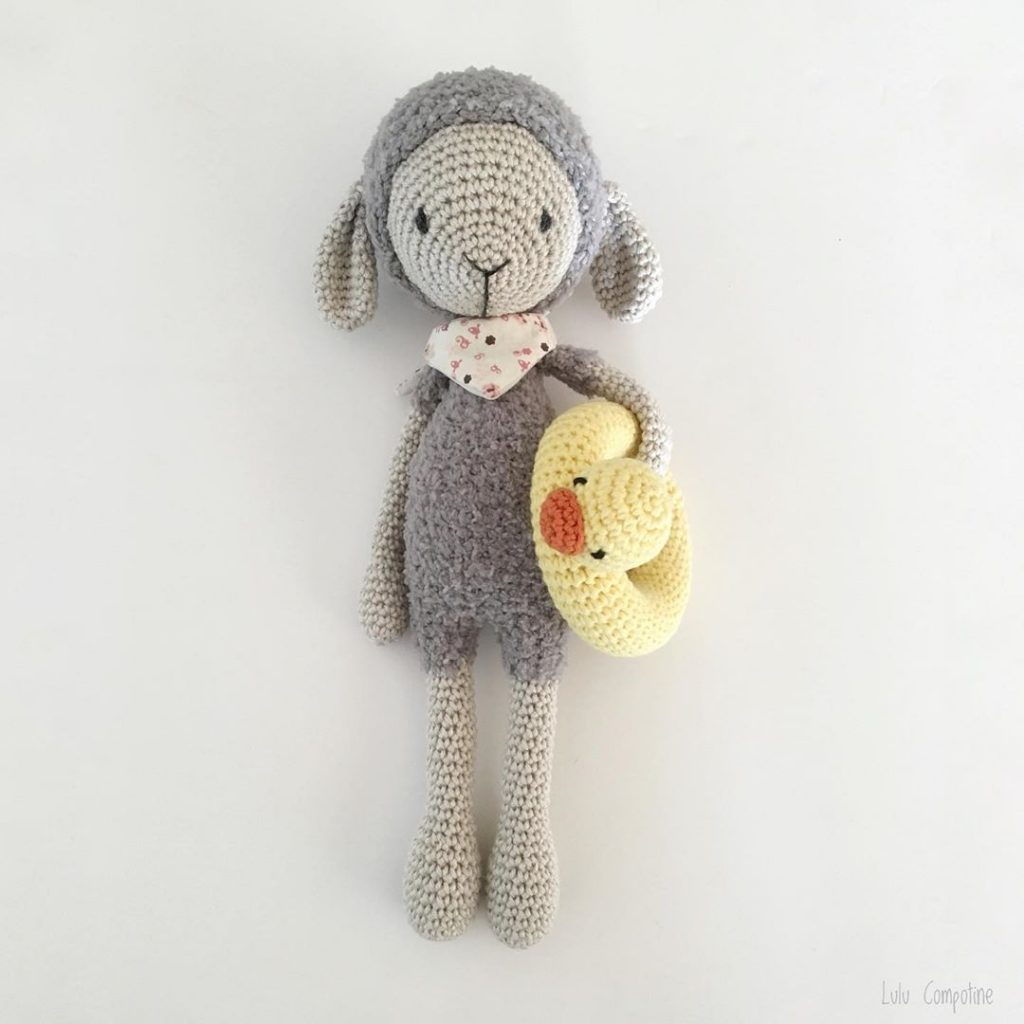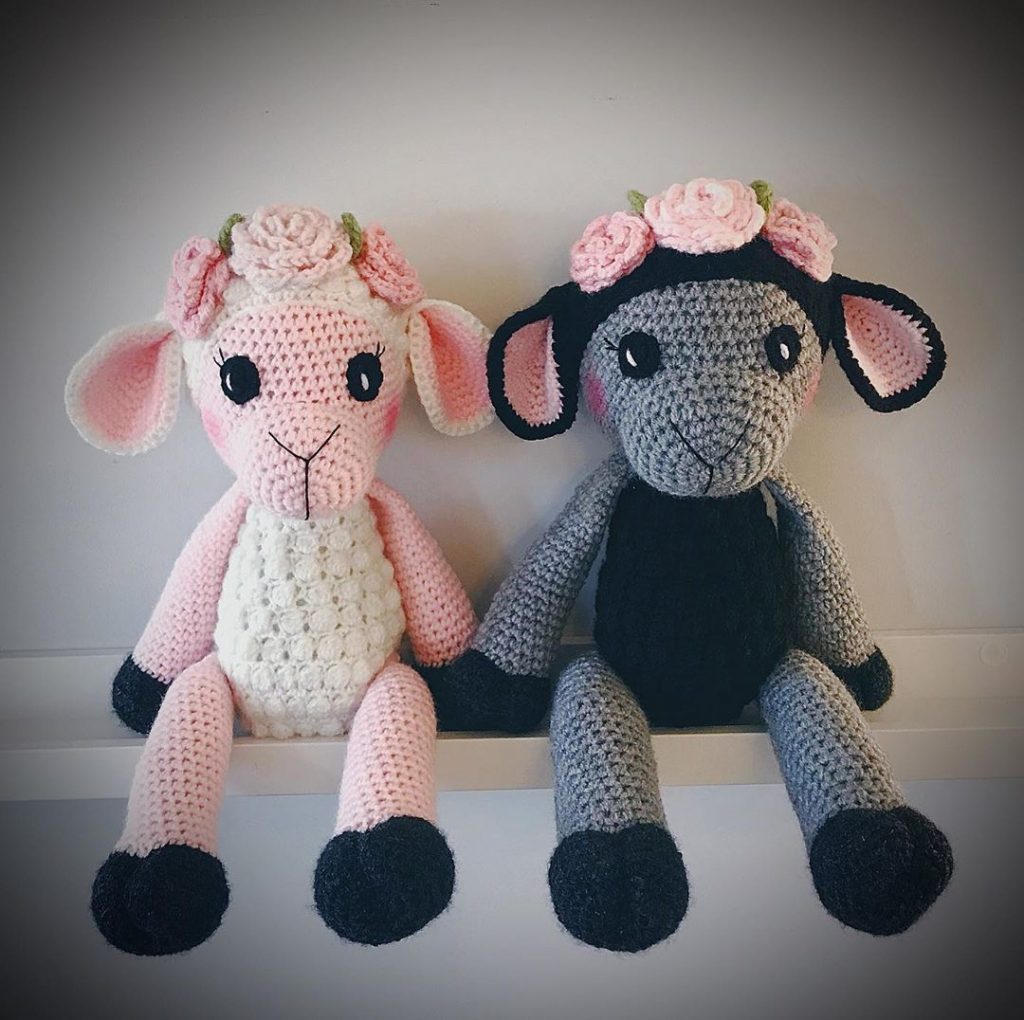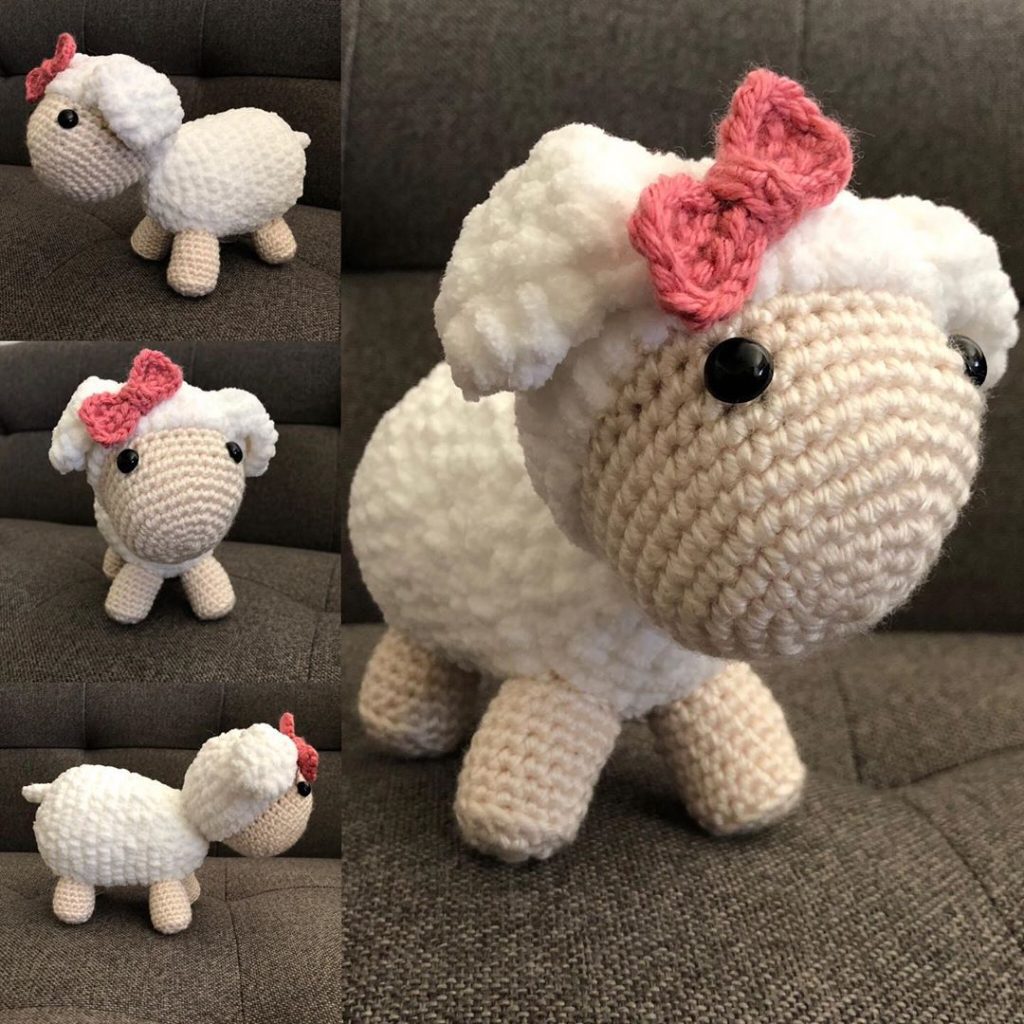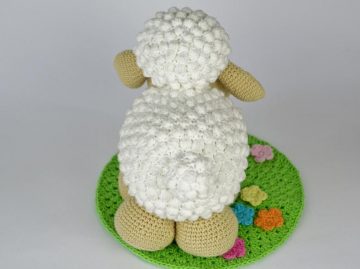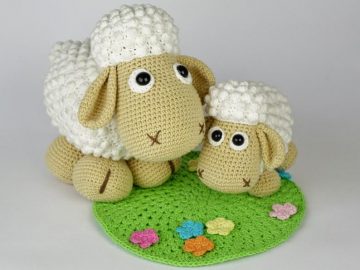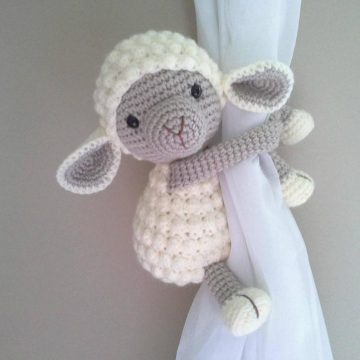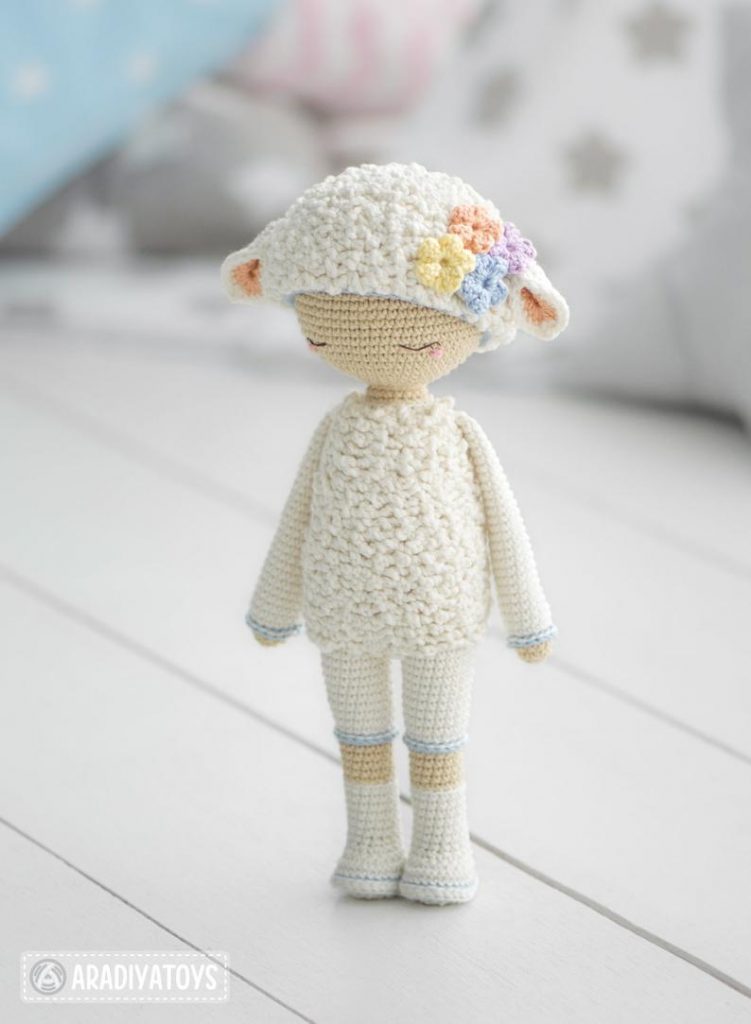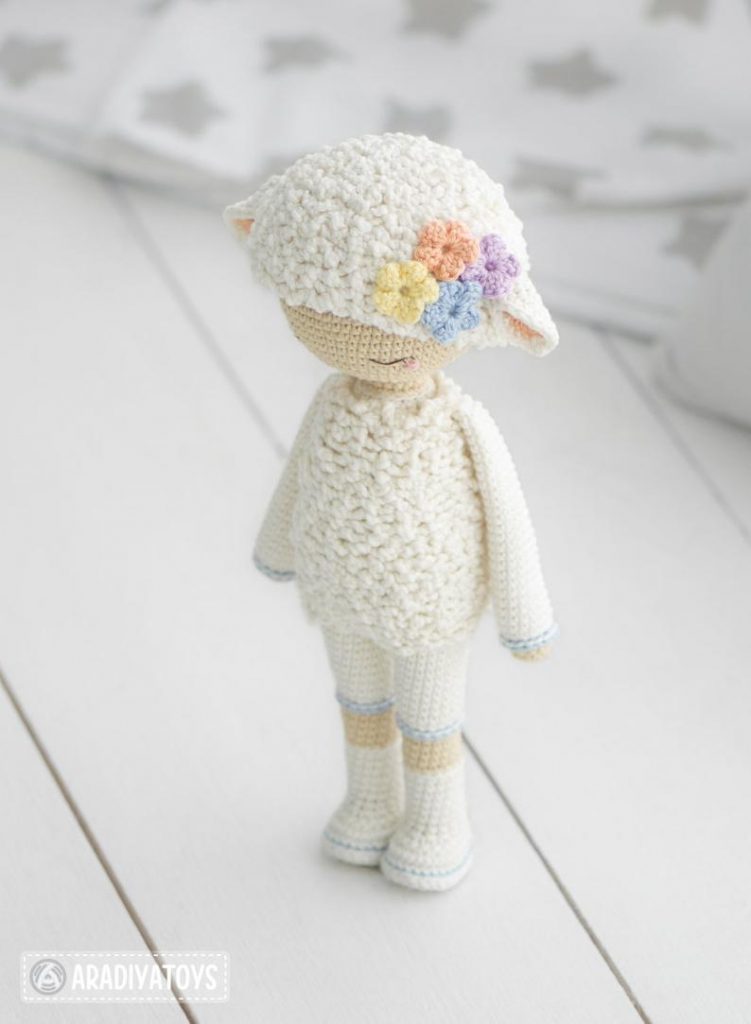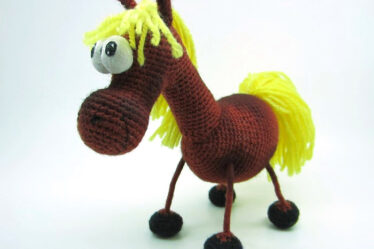Note: Bear made with materials below = 3-3/4 inches tall (9.5cm)
Lamb is 2.5 inches tall (6.5cm)
LIST OF SUPPLIES AND MATERIALS:
(Colors are suggested; use colors of choice.)
Size 20 crochet thread – Light Beige (DMC Mocha Cream used for model) – 100
yds, Red (shoes and dress) – 175 yds, Light Pink (apron, hat, dress trim) – 100
yds, White (bloomers and lamb) – 150 yds, Black (lamb’s hooves) – 10 yds, 5 yds
or less of Dark Pink and Brown for flower; or colors of choice
Black embroidery thread
Size 10 crochet hook
Fiberfill Stuffing
Two 4mm black eyes or beads for bear
Two 2mm black beads for lamb’s eyes
One ¾” cotter pin and two 3/8″ disks for bear’s neck joint
Upholstery, nylon, or other strong thread – in color similar to bear for jointing,
black for sewing on eyes
Sewing thread – pink, white (or to match colors used for apron, buttons, flowers)
One 6mm light pink heart button
Three 3mm light pink pearl beads to use as buttons
Two 6” (15cm) pieces of ¼”- (7mm-) wide ribbon, white or light pink
One 6” (15 cm) piece of ¼”- (7mm-) wide ribbon, pink and white gingham
Black fine-tip fabric marker for shading eyes
Pink water color pencil or make up for shading cheeks and mouth
Blue pencil or make up for shading eyelids
Brown pencil or make up for shading inside of ears
Small, sharp scissors
Sewing Needles, including a two-inch needle with an eye large enough to
accommodate the size thread or yarn that you are using (such as a nr 7 darner or a
nr 7 milliners for size 20), and a regular sewing needle.
Hemostat or long tweezers to aid in stuffing small areas
Small needle nose pliers for turning cotter pin legs (and crimping eye wires if
applicable)

GAGE: Gage is not important as long as you use the same size hook and thread for all
pattern pieces; however, since tension can vary in different circumstances, it is suggested
that when making two pieces that must be the same, such as arms and legs, that you
complete both in one sitting.
SPECIAL INSTRUCTIONS:
ADJUSTABLE RING: Grasp the thread between your thumb and forefinger, leaving a
tail at the beginning. Wrap the thread over and around the index finger clockwise,
crossing the thread at the top of the finger. Insert the hook underneath the front thread
that you just crossed, then catch the back thread with the hook, and pull a loop of the
back thread from underneath. Slip the loop off the finger, grasping the working end in
the left hand as if to begin crocheting. Chain 1, work number of stitches required into the
ring. Pull up a long loop, then, grasping the stitches just made with the right hand and
tail with left (or vice versa), pull to tighten ring. Insert hook into long loop and tighten
back against hook. Making sure tail is to the back, skip first chain worked and continue
working pattern.
IMPORTANT NOTE ON STUFFING: The way that you stuff your bear can greatly
affect the quality of the finished product, especially if you are thread-jointing. You’ll be
amazed at the quantity of stuffing that each piece requires. The bear should be stuffed
firmly so that it won’t lose its shape, but not so firmly that the stitches are pulled apart to
the extent that the stuffing shows through in a distracting manner.
WEAVING/HIDING LOOSE THREAD ENDS: When making the bear, you can hide
the loose ends by pulling them to the inside of the piece with a needle. Pass the needle
through the piece 2 or 3 times to anchor the thread end (always go in and come out
between stitches, being careful not to catch any fabric), then pull the thread taut, and clip
close to the surface so that it disappears inside.
For other pattern pieces, it’s best to weave all loose ends as you finish each piece. If you
can’t hide the beginning tail by working over it for a few stitches, leave a tail that is long
enough to enable you to thread it onto a needle to weave it. When you fasten off, always
leave a tail that is long enough to thread onto a needle and weave.
To weave: Thread the tail onto a needle. Working on the WS of the piece and beginning
directly beneath the place where you fastened off, insert the needle underneath and
through the upper loops of fabric for a length of 4 or 5 stitches, and then turn and repeat
in the opposite direction through the same number of stitches on the row directly below.

LITTLE BEAR PEEP
HEAD: (Vertical Muzzle)
1. Ch 7 with bear color, 2 sc in 2nd ch from hook, sc in next 4 ch, 2 sc in last ch,
continuing around to opposite side of chain, 2 sc in 1st free lp, sc in next 4 free lp, 2 sc in
last free lp; do not join – place a short piece of contrasting thread as a rnd marker. (16 sc)
2. Turn corner and sc in side bar of last sc made, 2 sc in next sc, sc in next 6 sc, 2 sc in ea
of next 2 sc, sc in next 6 sc, 2 sc in next sc. (21 sc)
3 – 6. Sc in ea sc around. (21 sc)
7. Sc in next 2 sc, move rnd marker to begin next rnd here (this is to adjust the starting
point; it does affect total stitch count), (2 sc in next sc, sc in next sc) 10 times, 2 sc in
next sc. (32 sc)
8. Sc in ea sc around. (32 sc)
9. Sc in next 6 sc, 2 sc in ea of next 3 sc, sc in next 5 sc, 2 sc in ea of next 2 sc, sc in next
6 sc, 2 sc in ea of next 3 sc, sc in next 6 sc. (40 sc)
10. Sc in ea sc around. (40 sc)
11. (2 sc in next sc, sc in next 3 sc) 10 times. (50 sc)
12– 15. Sc in ea sc around. (50 sc)
16. (Sc2tog, sc in next 3 sc) 10 times. (40 sc)
17. Sc in next sc, place a contrasting marker between the last sc made and the next one
(This will be left in place to help you locate the position for the neck joint.), sc in ea rem
sc around. (40 sc)
18. (Sc in next 2 sc, sc2tog) 10 times. (30 sc)
19. Sc in ea sc around. (30 sc)
INSERT COTTER PIN FOR NECK JOINT: Stuff the muzzle so that you can get a
better idea of where center is, and then place a disc onto a cotter pin. Reach inside the
head and, using the marker as a guide, insert the pin through the fabric and out the center
bottom of the head between rows 14 and 15, directly in line with the center line of the
muzzle, easing the pin through carefully so as not to tear the thread. Continue stuffing
the head so that you can be sure you have the cotter pin in the right place. If you find that
the cotter pin is off-center, take the stuffing out and do it again, adjusting the cotter pin to
center. Pull out the marking thread.
20. (Sc2tog, sc in next 2 sc) 7 times, sc2tog. (22 sc)
Continue to stuff head firmly, shaping as you go. Don’t forget to fill out the cheek
area on each side of the snout. Check shaping from all angles.
21. Sc in ea sc around. (22 sc)
22. (Sc2tog, sc in next sc) 7 times, sc in next sc. (15 sc)
23. Sc in ea sc around. (15 sc)
24. (Sc2tog, sc in next sc) 5 times; FO with sl st in next sc, leaving long end for closing.
(10 sc)
Add as much stuffing as you need to in order to round out the back of the head.
Thread the long end onto a needle and sew a row of gathering stitches in and out of
the front lps around rnd 24 sc; pull gently but firmly to gather and close. Run the
needle back and forth inconspicuously through the head a couple of times (always go
between stitches and don’t catch any of the fabric). Pull the yarn taut and carefully
clip close to the surface, so that the end disappears inside the head.
ATTACH EYES: Use pins (the kind with round glass heads are good for this) to locate
the eye positions. Sew the eyes on with nylon or other strong thread (use black if you are
using beads): Begin by threading a needle. Do not knot the end. Insert the needle
through the wire loop or bead, and then remove the thread from the needle. Always take
the needle in and out between stitches so as not to catch any fabric. (Crimp the wire loop
if applicable.) If you can’t get your needle through the bead, insert the thread through the
bead hole first. Thread both ends back onto the needle, and then insert the needle into
the first eye location. Bring the needle out the back of the head, pulling the bead or eye
wire against the face. If there is an eye wire, pull again to bring it into the face next to
the thread. Now pull the thread gently but firmly to slightly imbed the eye into the face.
Keeping the thread taut so as not to allow the eye to loosen, insert the needle back into
the exact place, then push through the head and out elsewhere two or three
times to anchor the thread and prevent the eye loosening. Tie off the ends
with a surgeon’s knot (see illustration at right), then thread the ends onto
the needle and insert back into the head in the same place where the knot
is; pull through to another place on the bottom of the head. Clip ends
close to the surface so that they disappear inside the head. Repeat the
process for the second eye.
NOSE: Embroider nose in a triangle shape using satin stitch with 4 strands of black
embroidery floss. Begin by knotting the thread and inserting the needle up through the
bottom of the muzzle, and coming out at center top of muzzle between rows 2 and 3. Tug
to pull knot inside head. Now bring the needle straight down from the exit point the
width of 2 or 3 rnds, depending upon where you want the longest point of
the nose to be, and insert back into the muzzle. This will be the bottom
point of the triangle for all the nose stitches. Make another stitch over the
first one, then make the next stitch beginning at the bottom center of the
nose, and ending in the space 1 sc to the right of the center stitch. Repeat
to the left. Now fill in the nose with more stitches made very close
together, always going into the same place at the bottom of the triangle.
MOUTH: With the same thread, embroider 1 vertical straight stitch of the desired
length, beginning at bottom center of nose and going downward the width of about 4 sc’s.
Next make a slight U stitch or an inverted v-stitch for mouth, with center being at the
bottom of the straight stitch that comes down from nose. Catch the center with a tiny
stitch that goes over the mouth stitch and back in the same place where the vertical
straight stitch ends. Use a pink fine-tip marker or a pink pencil to shade below the mouth
line in the shape of a little bowl (optional – don’t do it if you do not feel confident about
it). (See photos.)
EYEBROWS: Embroider a straight stitch about the length of 2 sc, following the lines
between rounds, for each brow.
EARS (Make 2):
1. Begin with an adjustable ring (see Special Instructions) with 5 sc in the ring; ch 1,
turn. (5 sc)
2. 2 sc in ea sc; ch 1, turn. (10 sc)
3. Row 3 is R. Be sure that the center lp is pulled tightly closed. Sc in next 2 sc, (2 sc
in next sc, sc in next sc) 3 times, sc in next 2 sc; turn corner and crochet in side bars of
last sc made, sc in next 2 row ends, sk ctr, sc in next 3 row ends; FO, leaving long end for
sewing ear to head. (19 sc)
ATTACH EARS: Thread the long end onto a needle and sew the bottom front edges
together with one stitch. Looking at the front of the head and thinking of its shape as a
clock, position the ears at about 10:00 and 2:00. Beginning at the muzzle, count
backward and pin the back edge of the left ear to the head between the 16th and 17th rnds.
Pin both the left and right front edges in place between rows 14 and 15. After you have
positioned the ears properly, sew the ears to the head with a few tiny stitches around the
bottom edge. Pass loose ends through the head 2 or 3 times to make sure that they are
well anchored; clip threads close to the surface so that they disappear inside the head.
Shade the inside of the ears with brown pencil or marker.
Use a blue pencil or make up to shade the eyelids.
Use a pink pencil or make up to shade the cheeks and below the mouth.
If desired, paint a tiny dab of white nail polish or acrylic paint in the center of each
eye as a highlight. After the paint is dry, paint the entire eye surface with clear nail
polish or nose glaze.
BODY:
1. Ch 2 with bear color, 6 sc in 2nd ch from hook; do not join, place rnd marker. (6 sc)
2. 2 sc in ea sc around; remove rnd marker, sc in next 3 sc; replace rnd marker (does not
change stitch count). (12 sc)
3. (2 sc in next sc, sc in next sc) 6 times. (18 sc)
4. (2 sc in next sc, sc in 2 sc) 6 times. (24 sc)
5. (Sc in next 3 sc, 2 sc in next sc) 6 times. (30 sc)
6. Sc in next 7 sc, 2 sc in ea of next 2 sc, sc in next 12 sc, 2 sc in ea of next 2 sc, sc in
next 7 sc. (34 sc)
7. Sc in next 9 sc, place a contrasting marker, sc in next 16 sc, place another contrasting
marker, sc in next 9 sc. (34 sc)
These two markers will be used to assist with placement of arms and legs, so be
careful not to pull them out as you work.
8 – 11. Sc in ea sc around. (34 sc)
ATTACH HEAD:
At this point push the cotter pin protruding from the bottom of the head into
the center opening at the top of the body. Reach inside the body to place a
disk onto the cotter pin and push flush toward head; then, reaching inside body with small
pliers, curl each side of cotter pin outward and down toward disk, until the curled leg is
resting on the disk.
12. Sc in next 10 sc, (2 sc in next sc, sc in next 2 sc) 5 times, 2 sc in next sc, sc in next 8
sc. (40 sc)
13 – 17. Sc in ea sc around. (40 sc)
18. (Sc2tog, sc in next 6 sc) 5 times. (35 sc)
19. (Sc in next 5 sc, sc2tog) 5 times. (30 sc)
20. (Sc2tog, sc in next 4 sc) 5 times. (25 sc)
21. (Sc in next 3 sc, sc2tog) 5 times. (20 sc)
22. (Sc2tog, sc in next 2 sc) 5 times. (15 sc)
Stuff body firmly.
23. (Sc in next sc, sc2tog) 5 times; FO with sl st in next sc, leaving a long end for
closing. (10 sc)
Thread the long end onto a tapestry needle, then sew a row of gathering stitches in
and out of the front lps around rnd 23; pull gently but firmly to gather and close.
Insert the needle into the center, and push through body and out elsewhere. Anchor
the end by running the threaded needle back and forth through the body 2 or 3 times.
Clip close to body so that the end disappears inside.
LEGS: (Make 2)
Shoe Sole:
1. Ch 7 with shoe color, sc in 2nd ch from hook, sc in next 5 ch, turn corner and sc in
side bars of last sc made; moving around to work on opposite side of ch, sc in next 6 free
lps, turn corner and sc in side bars of last sc made; do not join, place rnd marker. (14 sc)
2. 2 sc in next sc, sc in next 4 sc, 2 sc in ea of next 4 sc, sc in next 4 sc, 2 sc in next sc.
(20 sc)
3. 2 sc in next sc, sc in next 5 sc, 2 sc in ea of next 8 sc, sc in next 5 sc, 2 sc next sc;
remove rnd marker, sc in next 2 sc (the extra 2 stitches are made to make the back edge
of sole will be symmetrical – this does not affect the stitch count); FO with sl st in next
sc. (30 sc)
Shoe Upper:
Note: Keep stitches as tight as possible when decreasing (sc2tog). You do this by
making sure that all lps are as snug around your hook as is feasible.
4. With RS facing and beginning with the sl st on rnd 3, count 3 st backward toward
heel and join shoe color with sc in BL of 3rd st; sc in BL of next sc, sc in both lps of next
sl st, sc in BL of ea rem sc around; join with sl st in 1st sc, ch 1, do not turn. (30 sc)
5. Working in both lps, sc in same pl as joining and in ea rem sc around; join with sl st in
1 st sc (be careful not to mistake the ch-1 or sl st for the 1st sc), ch 1, do not turn. (30 sc)
6. Sc in same pl as joining and in next 10 sc, (sc2tog, sc in next sc) twice, sc2tog, sc in
next 11 sc; join with sl st in 1st sc, ch 1, do not turn. (27 sc)
7. Sc in same pl as joining and in next 9 sc, (sc2tog, sc in next sc) twice, sc2tog, sc in
next 9 sc; join with sl st in 1st sc, FO. (24 sc)
Leg:
8. With RS facing, join bear color with sc in same sc as joining at top edge of heel, sc in
next 7 sc, (sc2tog, sc in next sc) twice, sc2tog, sc in next 7 sc, sc2tog over the last sc and
the joining sl st; join with sl st in 1st sc, ch 1, do not turn. (21 sc)
9. You will now resume working in rounds. Sc in same pl as joining, sc in next 9 sc,
sc2tog, sc in next 8 sc, sc2tog over last sc and joining sl st; pl rnd marker. (20 sc)
10. Sk ch-1, sc in next 6 sc, (sc2tog, sc in next sc) twice, sc2tog, sc in next 6 sc. (17 sc)
11. Sc in next 8 sc, sc2tog, sc in next 7 sc. (16 sc)
Stuff foot, shaping with fingers to keep sole as flat as possible. Continue to stuff leg
every few rounds as you work.
12 – 13. Sc around. (16 sc)
14. Sc in next sc, replace rnd marker to begin rnd here (this is simply to center the
beginning point for the rnd; it does not change the stitch count), sc in next 7 sc, 2 in ea
of next 2 sc, sc in next 7 sc. (18 sc)
15 – 23. Sc around. (18 sc)
24. Sc2tog (this st should be at ctr back), sc in next 7 sc, sc2tog, sc in next 7 sc. (16 sc)
25. (Sc2tog, sc in next 6 sc) twice. (14 sc)
26. Sc in next 2 sc, (sc2tog, sc in next sc) 4 times; FO with sl st in next sc, leaving long
end. (10 sc)
Finish stuffing leg.
Thread end on needle, then sew a row of gathering stitches in and out of the front lps
around rnd 26; pull to close the end. Insert the needle into the top of leg and out
elsewhere on leg, pulling thread taut. Pull on thread firmly and clip close to leg.
Shoe Strap:
1. Leaving a tail at the beginning, ch 21 rather tightly with shoe color; FO, leaving a tail
at the end. The chain should fit snugly when wrapped around the ankle from the top edge
of the center back of the heel and back around to the same spot.
Place one end of the strap, RS out, at the center back of heel, just under the top edge
of the shoe; pin in place. Being careful not to twist it, wrap the strap around the front
of the ankle and back to center back. The two ends should touch.
ATTACH LEGS (See Appendix 1 for photos.):
(1) Using the marking threads on the body as a guide, use pins to experiment and (2) find
the placement for the legs; (3) mark the entry point for the joints on each side. Check
placement: with bear in a sitting position, bottom edge of legs should be even with
bottom of body. Thread a needle (long enough to pass easily through the body) with
upholstery or other strong thread in a color close to the bear color; double but do not knot
the end. (4) Insert needle into marked area on left hip of bear; push needle through body
and bring out at marked spot on right hip area. Pull through, leaving a 3″ (7.5cm) tail at
the beginning. (Leave threads loose until instructed to tighten them.) Insert needle into
body 1 sc above the protruding thread, push through body, and bring out 1 sc above the
beginning tail. Insert back into body in same place where tail protrudes, push through
and bring out at the same place on opposite side. * (5) Insert needle through leg from
inside to outside, between rows 23 and 24; pull thread through until leg is about 1″
(2.5cm) from body. (6) Turn needle and insert it back into the same place where it
came out, and push it back through to the inside of the leg, dipping the point down
as you go through in order to catch some stuffing, and bringing it back out in the
exact spot where the joint thread is. (7) Insert back into body in same place where
joint thread comes out, then push back through the body** and bring it out where
the beginning tail protrudes. Repeat * to ** for right leg. (8) Now insert the needle
back into the leg in the same place and push through the leg, out the same place, and back
into body at the same place. (9) Push through the body again, and bring the needle out
just in front of the top edge of the leg. Pull the thread through and snug legs against
body. For extra security, run the thread back and forth through the body 2 or 3 more
times. Tie the ends off with a surgeon’s knot. Thread the ends onto the needle and insert
back into the same place where the knot is, push through the body and out the other side.
Clip the thread close to the body so that the ends disappear inside. Clip the beginning
tail.
Don’t be discouraged if your first attempts at thread jointing are not very good. After
more than 10 years of making crocheted bears, I still sometimes have to do a joint
more than once to get it right.
ARMS (Make 2):
1. Using bear color, begin with an adjustable ring, making 6 sc in ring; do not join, place
rnd marker. (6 sc)
2. 2 sc in ea sc around; remove rnd marker, continue on and make 3 sc (This is to adjust
the symmetry of the piece – it does not change stitch count.); pl rnd marker. (12 sc)
3. (2 sc in next sc, sc in next 5 sc) twice. (14 sc)
4. (2 sc in next sc, sc in next 6 sc) twice; (16 sc)
With certain types of thread, you may find that your adjustable ring tends to open up
as you work. To avoid this problem, go to the back of your work at this point and
weave the beginning tail (see Special Instructions for tips on weaving ends).
5 – 7. Sc in ea sc around. (16 sc)
8. Shaping round. Sc2tog, sc in next 6 sc, sc2tog, sl st loosely in FL of next 6 sc. (8 sc,
6 sl st)
9. Shaping round. Sc2tog, sc in next 4 sc, sc2tog, sl st loosely in FL of next 6 st. (6 sc,
6 sl st)
10. Sc in next 6 sc, sc in FL of next 6 sl st. (12 sc)
11. (2 sc in next sc, sc in next 5 sc) twice. (14 sc)
Stuff paw. (Shaping stitches are on the inside of the paw toward the body, and will
force the paw to bend slightly inward.)
Continue to stuff arm after every few rnds as you work.
12 – 22. Sc in ea sc around. (14 sc)
23. (Sc in next 5 sc, sc2tog) twice. (12 sc)
24. (Sc in next 4 sc, sc 2tog) twice; FO with sl st in next sc, leaving a long end for
closing. (10 sc)
Finish stuffing.
Thread the end on a needle, then sew a row of gathering stitches in and out of the
front lps around rnd 24; pull gently but firmly to close. Secure the thread, anchor,
and clip same as for body.
With 2 strands of black embroidery floss, make 3 long straight stitches around the
end of each paw.
ATTACH ARMS (See Appendix 1):
Using the marking threads on the body as a guide, use pins to experiment and (2) find the
placement for the arms; if the joint spots are other than the marking threads, mark the
entry point for the joints on each side. Thread your needle with upholstery or other
strong thread in a color to match the bear; double but do not knot the end. Insert needle
into marked area on left shoulder of bear; push needle through body and bring out at
marked spot on opposite shoulder. Pull through, leaving a 3″ (7.5cm) tail at the
beginning. (Leave threads loose until instructed to tighten them.) Insert needle into body
1 rnd below the protruding thread, push through body, and bring out 1 rnd below the
beginning tail. Insert back into body in same place where tail protrudes, push through
and bring out at the same place on opposite side. * Insert needle through arm for this
side, from inside to outside, between rows 22 and 23; pull thread through until arm
is about 1″ (2.5cm) from body. Turn needle and insert it back into the same place
where it came out, and push it back through to the inside of the arm, dipping the
point down as you go through in order to catch some stuffing, and bringing it back
out in the exact spot where the joint thread is. Insert back into body in same place
where joint thread comes out, * then push back through the body and bring it out
where the beginning tail protrudes. Repeat * to * for the other arm. Push through the
body again, and bring the needle out just in front of the opposite arm. Pull to bring arms
snugly against body. For extra security, run the thread back and forth through the body 2
or 3 more times. Tie the ends off with a surgeon’s knot. Thread the ends onto the needle
and insert back into the same place where the knot is, push through the body and out the
other side. Clip the thread close to the body so that the ends disappear inside. Clip the
beginning tail.
Your bear should now look something like this:

CLOTHING FOR LITTLE BEAR PEEP
BLOOMERS:
1. Ch 46 with white, sc in 2nd ch from hook and in ea ch across; ch 1, turn. (45 sc)
2 – 5. Sc across; ch 1, turn. (45 sc)
6. Sc across; join with sl st in 1st sc; ch 1, turn. (45 sc)
7 – 9. Sc across; join; ch 1, turn. (45 sc)
First leg:
10. Sc in next 23 sc, ch 8, sk 22 sc; join with sl st in 1st sc, FO. (23 sc, 8 ch)
11. This row will be worked on WS. With back opening on your right, join with sc in
FL of 4th ch of ch-8, sc in FL of next 3 ch, sc in next 22 sc, sc in next 3 ch; join with sl st
in 1st sc, ch 1, turn. (30 sc)
12 – 15. Sc in ea sc around; join with sl st in 1st sc, ch 1, turn. (30 sc) 15
16. Sc in BL of ea sc around; join with sl st in next sc, ch 1, do not turn. (30 sc)
17. Sc in ea sc around; join with sl st in 1st sc, ch 1, do not turn. (30 sc)
18. Sc in ea sc around; join with sl st in 1st sc, ch 3, do not turn. (30 sc)
19. Bottom Ruffle: Dc in same pl as turning, (3 dc in next sc, 2 dc in next sc) around to
last sc, 3 dc in last sc; join with sl st in top of beg ch-3; FO. (75 dc)
Top Ruffle: With waist opening toward you, join white with sl st in 1st free lp on inside
of leg at row 15, ch 3, 2 dc in same pl, (2 dc in next free lp, 3 dc in next free lp) around to
last free lp, 2 sc in last free lp; join with sl st in top of beg ch-3; FO. (75 dc)
Second leg:
10. With waist opening toward you and working on RS, join with sc in next sc after 1st
leg on row 10; sc in next 22 sc; FO. (23 sc)
11. With back opening on your left and working on WS of second leg opening, join
white with sc in 4th of 8 free lps at crotch, sc in next 4 free lps, sc in next 23 sc around
leg opening, sc in next 3 free lps; join with sl st in 1st sc. (30 sc)
12 – 24. Repeat rows 12 – 24 of first leg.
Make ruffles same as you did for first leg.
Waist:
1. Ch 25; with RS facing, attach with sc in 1st free lp at left edge of waist, (sc2tog over
next 2 free lps, sc in next 2 free lps) 11 times, ch 28; FO. (one ch-25 tie, one ch-28 tie,
34 sc)
Clip thread near the end of each tie. Put a tiny bit of clear glue, clear nail polish, or
fray preventer on the end of each tie.
Weave all loose ends.
Put the bloomers onto the bear and close with the ties in the back. After you’ve
checked the fit, remove bloomers and set aside. It’s easier to put the dress on if the
bloomers are not on the bear.
DRESS:
Bodice:
1. Row 1 is RS. With dress color ch 41, hdc in 3rd ch from hook and in each ch across;
ch 1, turn. (40 hdc)
Right back:
2 – 4. Hdc in next 9 hdc; ch 1, turn. (9 hdc)
5. Hdc in next 9 hdc; do not ch 1; turn. (9 hdc)
6. Sl st in next 5 hdc; ch 1, hdc in next 4 hdc, ch 1, turn. (5 sl st, 4 hdc)
7. Hdc in next 4 hdc; FO, leaving 6” length of thread for sewing shoulder seam. (4 hdc)
Front:
2. With WS facing, skip 3 hdc after left back, attach dress color in next hdc with sl st, ch
1, hdc in same place, hdc in next 14 hdc; ch 1, turn. (15 hdc)
3 – 5. Hdc in ea hdc across; ch1, turn. (15 hdc)
6. Hdc in next 4 hdc, ch 1, sl st loosely in next 7 hdc, ch 1, hdc in next 4 hdc; ch 1, turn.
(8 hdc, 7 sl st)
7. Hdc in next 4 hdc, sl st in side of hdc just made, sl st loosely in next ch-1, sl st loosely
in next 7 sl st, sl st in next ch-1 ch 1, hdc in next 4 hdc; FO. (8 hdc, 10 sl st, 1 ch)
Left back:
2. With RS facing, sk 3 hdc after front, join dress color with sl st in next hdc, ch 1, hdc in
same hdc and in next 8 sc; ch 1, turn. (9 sc)
3 – 5. Hdc in next 9 hdc; ch 1, turn. ( 9 hdc)
6. Hdc in next 4 hdc; ch 1, turn. (5 sl st, 4 hdc)
7. Hdc in next 4 hdc; FO black, leaving 6” length of thread for sewing shoulder seam. (4
hdc)
Turn dress inside out and sew shoulder seams.
Weave loose thread ends.
Skirt: Beg ch-2 will count as hdc unless otherwise noted.
1. With RS of bodice facing, join dress color with sl st in free lp at bottom edge, ch 2,
hdc in same pl, (hdc in next free lp, 2 hdc in next free lp) across; turn. (60 hdc)
2 – 3. Sl st in 1st hdc, ch 2, dc in ea hdc across; ch 2, turn. (60 hdc)
4. Hdc in ea hdc around; join with sl st in top of beg ch; ch 2, turn. (60 hdc)
5 – 10. Hdc in ea hdc across; join with sl st in top of beg ch-2, ch 2, turn. (60 hdc)
11. Hdc in ea hdc around; ch 3, turn. (60 hdc)
12. Dc in same pl as joining, 2 dc in ea sc around; join with sl st in top of beg ch-3, FO.
(About 150 dc – Don’t worry about being exact on this count.)
13. With bottom edge facing up and working in BL, join pink on RS with sc 1st dc, (ch 2,
sl st in same pl, sc in next 2 dc) around, end with sc in next sc (or in pattern, depending
upon your stitch count), join with sl st in 1st sc; FO.
Back Button Placket:
1a. Working in row ends with RS facing, attach dress color with sc in 1st row end at top
edge of right side of back; working down right edge, sc in next 5 row ends to waist, sc in
sp bet bodice and skirt, sc in next 5 row ends to bottom, sl st in center bottom bet right
and left side;
1b. Working up the left edge, sc in next 5 row ends to waist, sc in sp bet skirt and
bodice, sc in next 5 row ends, sc in last row end at top left edge;
1c. Ch 2, turn corner and sc in 1st sc on left edge of neck opening, sc in next 2 sc, sc2tog,
sc2tog over next 2 row ends on left shoulder, sc in next row end, sk seam, sc in next row
end, sc2tog over next 2 row ends, sc2tog over next row end and next sl st, sc2tog on
bodice front, sc in next sl st, sc2tog, sc2tog over next sl st and next row end on right
shoulder, sc in next row end, sk seam, sc in next row end, sc2tog over next row end and
next sl st on back edge, sc2tog, sc in next 2 sl st, sc in next row end, ch 3;
1d. Turn corner and sk row end and next sc, sc in next 2 sc, (ch 2, sk next sc, sc in next 2
sc) twice, sl st in next 2 sc; FO. (39 sc, 3 sl, and 3 ch-2 buttonholes showing)
Neckline Trim:
1. With RS facing you and working in BL around the neck edge, join trim color with sl st
in 1st sc at left back opening, ch 2, sl st in same pl, *(sl st in next 2 sc) twice, ch 2, sl st in
same place*; repeat * to * 10 times, sl st in next sc, sl st in 1st ch of next ch-3, ch 2, sl st
in same pl: FO. (12 picots)




Sleeves:
Left Sleeve:
1. With RS facing, join dress color with sc in 2nd sc at underarm, sc in next sc, sc in
corner, make 8 hdc evenly spaced to shoulder seam, hdc in seam, make 8 hdc evenly
spaced to underarm corner, sc in corner, sc in next sc under arm; join with sl st in 1st sc,
ch 1, do not turn. (5 sc, 17 hdc)
2 – 7. Sc in same sc as joining and in next 2 sc, hdc in next 17 hdc, sc in next 2 sc; join
with sl st in 1st sc; ch 1, do not turn. (5 sc, 17 hdc)
8 – 9. Hdc in same pl as joining and in ea sc and hdc around; join with sl st in 1st hdc, ch
1, do not turn. (22 hdc)
10. Sc in same pl as turning, sc2tog 10 times, sc in next hdc; join with sl st in 1st sc, FO.
(12 sc)
Right Sleeve:
1. With RS facing, join dress color with sc in 3rd sc from right (your right) at underarm,
sc in next sc, sc in corner, make 8 hdc evenly spaced to shoulder seam, hdc in seam,
make 8 hdc evenly spaced to underarm corner, sc in corner, sc in next 2 sc under arm;
join with sl st in 1st sc, ch 1, do not turn. (5 sc, 17 hdc)
2 – 7. Sc in same sc as joining and in next sc, hdc in next 17 hdc, sc in next 3 sc; join
with sl st in 1st sc; ch 1, do not turn. (5 sc, 17 hdc)
8 – 9. Hdc in same pl as joining and in ea sc and hdc around; join with sl st in 1st hdc, ch
1, do not turn. (22 hdc)
10. Sc in same pl as joining, sc2tog 10 times, sc in next hdc; join with sl st in 1st sc, FO.
(12 sc)
Weave loose ends.
Sew three 3mm light pink pearl beads to left side opposite the ch-2 buttonholes.
Put the dress onto the doll and fasten buttons. Since the sleeves were designed to fit
around the wrist, you may need to gently force the bottom edge of the sleeve over the
bear’s hand.
You may tack the back together to keep it from coming unbuttoned, if you wish.
Put the bloomers back on the bear and tie the back ties. If you wish, in order to keep
them in place, tack the bloomers in place with a few stitches around the waist.
APRON:
Waistband:
1. Row 1 is RS. Ch 44 with pink, sc in 2nd ch from hook and in ea ch across; ch 1, turn.
(43 sc)
2. Sc across; FO. (43 sc)
With the dress on the bear, the piece should fit easily around the bear without having
to stretch it, with the ends meeting at center back. If your piece is too long or too
short, adjust your hook size accordingly.
Skirt: Beginning Ch-3 counts as dc unless otherwise instructed.
3. With RS facing and with row 2 facing up, sk 16 sc and join apron color with sl st in
BL of the next sc, ch 3, 2 dc in same pl, 3 dc in BL of ea sc across; ch 3, turn. (33 dc)
4. Dc in same pl as turning, (sk next dc, sc in next dc, sk next dc, 3 dc in next dc) 7
times, sk next dc, sc in next dc, sk next dc, 2 dc in last dc; ch 1, turn. (7 3-dc shells, 2 2-
dc half shells)
5. Sc in 1st dc, (sk next dc, 3 dc in next sc, sk next dc, sc in next dc) 8 times; ch 3, turn.
(8 dc shells)
6. Dc in same pl as turning, (sk next dc, sc in next dc, sk next dc, 3 dc in next sc) 7 times,
sk next dc, sc in next dc, sk next dc, 2 dc in last sc; ch 1, turn. (7 3-dc shells, 2 2-dc half
shells)
7. Sk next 2 dc, (3 dc in next sc, sk next dc, sc in next dc, sk next dc) 7 times, sk next dc,
3 dc in next sc, sl st in same pl; ch 1, turn. (8 shells)
8. Sk sl st and next dc, (sc in next dc, sk next dc, 3 dc in next sc, sk next dc) 7 times, sk
next dc, sc in next dc; ch 1, turn. (7 shells)
9. Sk next sc and next dc, (sc in next dc, sk next dc, 3 dc in next sc, sk next dc) 6 times,
sk next dc, sc in next dc; ch 1, turn. (6 shells)
10. Sk next sc and next dc, (sc in next dc, sk next dc, 3 dc in next sc, sk next dc) 5 times,
sk next dc, sc in next dc; ch 1, turn. (5 shells)
11. Sk next sc and next dc, (sc in next dc, sk next dc, 3 dc in next sc, sk next dc) 4 times,
sk next dc, sc in next dc; ch 1, turn. (4 shells)
12. Sk next sc and next dc, (sc in next dc, sk next dc, 3 dc in next sc, sk next dc) 3 times,
sk next dc, sl st in next dc; FO. (3 shells)
Trim. For this row, you will work in row ends and stitches around the edge of rows
3 – 12 of the apron skirt.
13. With RS facing, join pink with sl st at top edge of skirt in the space between row 2 of
waist band and row 3 of skirt, sc around the outer edge of the apron in stitches and row
ends 46 times, ending with a sl st in sp bet rows 3 and 2; FO. Don’t worry if your stitch
count is not exactly 46, as long as the edge looks smooth and even. (46 sc, 2 sl st)
14. Working in BL this row with RS facing, join white with sl st in 1st sc on row 13, [(sc,
ch 2, sl st) in next sc, sc in next sc]; repeat within [ ] across to final sl st; FO with sl st in
last sl st.
Bib:
1. With RS facing you, join pink with sl st in 18th free lp top on top edge of waist band,
ch 3, 2 dc in same pl, (sk next free lp, sc in next free lp, sk next free lp, 3 dc in next free
lp) twice; ch 1, turn. (3 3-dc shells)
2. Sc in next 2 dc, (sk next dc, 3 dc in next sc, sk next dc, sc in next dc) twice, sc in last
dc; ch 1, turn. (2 3-dc shells)
Left Strap:
1. Sc in next 2 sc; ch 1, turn. (2 sc)
2 – 14. Sc in next 2 sc; ch 1, turn. (2 sc)
15. Sc in next 2 sc; FO, leaving long end for sewing strap to back of band. (2 sc)
Right Strap:
1. With RS facing, sk the 2 shells after the left strap and join pink with sc in next sc; sc
in next sc; ch 1, turn. (2 sc)
2 – 15. Work same as 2 – 15 of left strap. (2 sc)
Carefully and neatly sew the bottom edge of each strap to the top edge of the back of
the waist band, one at each end. Weave all loose ends.
Strap Trim (Optional):
1. Left strap: With RS facing, join white with sl st on the left side (bear’s left) in the
corner space where the waist band and the bib meet, 2 sc in ea of next 2 row ends (for a
total of 4 sc on edge of bib, [in next row end make hdc, (3 dc in same pl)] 13 times, hdc
in next row end, sc in next row end, and sl st in corner sp between strap and waist band.
2. Right Strap: With RS facing, join white with sl st on the right side (bear’s right) in
the corner space where the waist band and the strap meet, sc in next row end, hdc in next
row end, (in next row end make 3 dc, hdc in same pl) 13 times, 2 sc in ea of next 2 row
ends (for a total of 4 sc on edge of bib, sl st in corner sp between strap and waist band.
Apron Ties:
Take one of the 6” pieces of ribbon (the end should be cut flat across) and turn under to
WS. Sew a tiny row of gathering stitches close to the end; pull to gather the ribbon to the
width of the waist band of the apron. Secure the thread so the the ribbon stays at that
width. Trim frayed ends. With WS down, sew the gathered end of the ribbon securely to
the edge of the apron waist band. Repeat for 2nd tie.
Sew the light pink heart button to the center front of the bib (see photos).
Weave all loose ends.
Put the apron onto the bear and close the back with the ribbon ties. Tie into a bow
and trim ends to desired length. Cut a notch in the end of each tie. You may want to
brush the ends with a little clear nail polish or fray preventer.
Attach ties and put apron on bear.
CAP:
1. Begin with an adjustable ring using pink, making 6 sc in ring; join with sl st in 1st sc,
ch 1, do not turn. (6 sc)
2. 2 sc in ea sc around do not join, pl rnd marker. (12 sc)
3. Sk sl st and ch-1, 2 sc in ea sc around. (24 sc)
4. (2 sc in next sc, sc in next sc) 12 times. (36 sc)
5 – 6. Sc in ea sc around. (36 sc)
7. (2 sc in next sc, sc in next 2 sc) 12 times. (48 sc)
8 – 9. Sc in ea sc around. (48 sc)
10. (2 sc in next sc, sc in next 3 sc) 12 times. (60 sc)
11. Sc in ea sc around. (60 sc)
12. (2 sc in next sc, sc in next 4 sc) 12 times. (72 sc)
13 – 16. Sc in ea sc around. (72 sc)
17. (Sc2tog, sc in next sc) 24 times around. (48 sc)
18 – 19. Sc in ea sc around. (48 sc)
20. (Sc2tog, sc in next 23 sc) twice. (46 sc)
Important Note: For the next round you will need to adjust the ear openings to
conform to your bears head. Place the cap on the head and mark where the openings
need to be using colored thread. Make more or fewer sc between the ears, as needed.
You can also adjust the number of chains for each ear space, and skip more or fewer
sc as needed.
21. Sc in next 14 sc, ch 6, sk next 4 sc, sc in next 12 sc, ch 6, sk next 4 sc, sc in next 15
sc. (41 sc, 2 ch-6 sp)
22. Sc in ea sc and in ea ch around. (53 sc)
22. Working this round in BL, sl st in next sc, ch 2, 2 hdc in same pl, 3 hdc in ea sc
around; join with sl st in top of beg ch-2; FO. (159 hdc)
23. With RS facing, join white with sc in 1st hdc, ch 2, sc in same pl, sc in next sc, (sc in
next sc, ch 2, sc in same pl, sc in next sc) around; join with sl st in 1st sc; FO.
Weave loose ends.
If desired, make a flower from the pattern below and sew to hat at front end of left ear
opening (bear’s left).
Place cap on bears head, carefully easing the ears through the ear holes. The ears
will probably hold the cap on the head, but if not, you may want to tack the cap to the
head in a few places.
Flower:
1. With brown or yellow ch 2, 5 sc in 2nd ch from hook; join in 1st sc, FO. (5 sc)
2. Join flower color of choice with sl st in BL of 1st sc; ch 4, sc in 2nd ch from hook and
in next 2 ch, sl st in same sc; (sl st in BL of next sc, ch 4, sc in 2nd ch from hook and in
next 2 ch, sl st in same sc) 4 times; join with sl st in first sc. (5 petals)
LAMBIE PIE:
Head (Horizontal Muzzle):
1. Ch 4, 2 sc in 2nd ch from hook and in next 2 ch, move around to other side of ch, and
make 2 sc in ea of the next 3 free lps; do not join. (12 sc)
2. (2 sc in next sc, sc in next sc) 6 times. (18 sc)
3 – 4. Sc in ea sc around. (18 sc)
5. (2 sc in next sc, sc in next 2 sc) 6 times. (24 sc)
6. (2 sc in next sc, sc in next 3 sc) 6 times. (30 sc)
7. Sc in next 8 sc, 2 sc in ea of next 5 sc, sc in next 17 sc. (35 sc)
8 – 11. Sc in ea sc around. (35 sc)
12. Sc in next 10 sc, sc2tog 5 times, sc in next 15 sc. (30 sc)
13. Sc in ea sc around. (30 sc)
14. (Sc2tog, sc in next 4 sc) 5 times. (25 sc)
15. Sc in ea sc around. (25 sc)
16. (Sc2tog, sc in next 3 sc) 5 times. (20 sc)
17. (Sc2tog, sc in next 2 sc) 5 times. (15 sc)
Stuff head.
18. (Sc in next sc, sc2tog) 5 times; FO, leaving long end for closing. (10 sc)
Finish stuffing head.
Use the long end to close the back of the head by sewing a gathering stitch in and out
around the FL around rnd 18. Pull firmly to close the center opening. Pass the
needle underneath the next stitch to secure, and then pass through the head, in one
spot and out another, always between stitches, 2 or 3 times to anchor the end. Clip
close to the surface so that the end disappears inside.
NOSE: It’s helpful to look at a picture of a lamb while you’re working on the features.
Use 2 strands of black, brown, or pink embroidery floss to make the nose, depending on
the look you want. Make the nose using 2 tiny straight stitches to make a “V” at the end
of the muzzle (see photos).
MOUTH: Continue with the 2 strands of floss from the nose and make a vertical straight
stitch beginning at the bottom point of the “V” and coming down the length of 1 row.
For the mouth, make a larger inverted “V” stitch with the center top point touching the
bottom of the vertical stitch.
EYES: Use about 12″ (28cm) of black or whitish nylon or other strong thread to attach
the eyes. (If you use black for the lamb, you’ll have to be very careful with your stitching
so as not to leave any black “spots” showing through the fabric.) When dealing with tiny
eye beads, you can either use a beading needle to get the thread through the center hole,
or if you don’t have a beading needle, insert the thread directly through the bead hole
without using a needle.
*After your eye bead is threaded, bring the two tails of thread together, and thread them
onto a 2-inch (5cm) needle. Insert the needle into the eye location, and pass it through
and out the back of the head. Be very sure to take your needle in and out between
stitches. Do not catch any fabric during this process; if you do, you’ll end up with ugly
indentations on the back of your lamb’s head! Pull the thread to slightly imbed the eye
into the face. Hold the eye in place with your opposite thumb while you run the threaded
needle back and forth thru the head 2 or 3 times to anchor the end. Clip the thread close
to the surface so that it disappears inside the head. ** Repeat * to ** for the 2nd eye.
EARS (Make 2):
1. Ch 11 with white, sc in 2nd ch from hook and in next 9 ch; move around to opposite
side of ch and sc in ea of the 10 free lps; ch 1, turn. (20 sc)
2. Row 2 is the right side. Sc in next 2 sc, hdc in next 5 sc, sc in next sc, sl st in next 2
sc, ch 2, sl st in 2nd ch from hook, sl st in next 2 sc, sc in next sc, hdc in next 5 sc, sc in
next 2 sc, ch 1, turn corner and (sk next row end, sc in next row end) twice; FO with sl st
in same pl as last sc, leaving long end for sewing. (6 sl st, 8 sc, 10 hdc)
With RS out, fold ear in half vertically and tack the 2 bottom front edges together.
Pin the ears to the head, moving them around until the position looks right. The ears
should be rather far towards the back of the head, and down on the sides of the head.
The inside of the ear should be facing slightly forward. See photos for guidance.
Sew ears in place.
Shading: With a light pink water color pencil or makeup blush, shade the inside of
the ears and the cheeks. Also use pink to very lightly shade inside the “V” of the nose,
and inside the “inverted V” of the mouth.
Legs: (Make 4)
1. Ch 4 with black, 2 sc in 2nd ch from hook, sc in next ch, 2 sc in next ch; move around
to opposite side of ch and make 2 sc in next free lp, sc in next free lp, 2 sc in next free lp;
ch 1, turn. (10 sc)
2. Row 2 is RS. Sc in next sc, sc in next 9 sc; FO. (10 sc)
3. With RS facing, join lamb color in BL of 1st sc, sc in next 9 sc, ch 1, turn corner and
sk white row end, sc in next 4 row ends; join with sl st in 1st sc, ch 1, do not turn. (14 sc)
Turn piece RS out.
4. Sc in same pl as joining, sc in next 2 sc, sc2tog twice, sc in next 3 sc, sk ch-1, sc in
next sc, sc2tog, sc in next sc; do not join, pl rnd marker. (11 sc)
5. Sk sl st and ch-1, sc in ea sc around. (11 sc)
6. Sk next sc, sc in next 10 sc. (10 sc)
Begin stuffing leg, and continue stuffing every few rnds as you work.
7 – 20. Sc in ea sc around. (10)
21. Sc in next 4 sc, sl st in next sc; do not work in rem sc, FO, leaving long end for
closing. (11 sc showing)
Thread the long end onto a needle; sew a gathering stitch, taking the needle in and
out around the FL’s of rnd 21. Pull to gather and close. Insert the needle into the top
of the leg and bring out elsewhere on leg. Pass the needle back and forth through the
leg 2 or 3 times to anchor the thread. Clip close to the surface so that the end
disappears inside the leg.
Body:
1. Ch 4, 2 sc in 2nd ch from hook and in next 2 ch, move around to opposite side of ch
and make 2 sc in ea of the 3 free lps; do not join, pl rnd marker. (12 sc)
2. Sc in next 2 sc, 2 sc in next sc, sc in next 5 sc, 2 sc in next sc, sc in next 2 sc. (14 sc)
3. Sc in next 3 sc, 2 sc in next sc, sc in next 2 sc, 2 sc in next sc, sc in next 3 sc, 2 sc in
next sc, sc in next 2 sc, 2 sc in next sc. (18 sc)
11. Sc2tog, sc in next 13 sc, (2 sc in next sc, sc in next sc) 3 times, 2 sc in next sc, sc in
next 12. (37 sc)
12. Sc in ea sc around. (37 sc)
13. Sc in next 15 sc, (2 sc in ea next sc, sc in next sc) 3 times, 2 sc in next sc, sc in next
15 sc. (41)
Stuff neck.
14. Sc in next 17 sc, (2 sc in ea next sc, sc in next sc) 3 times, 2 sc in next sc, sc in next
17 sc. (45 sc)
15. Sc2tog, sc in next 17 sc, (2 sc in next sc, sc in next sc) 3 times, 2 sc in next sc, sc in
next 19 sc. (48 sc)
16. Sc in next 21 sc, (2 sc in next sc, sc in next sc) 3 times, 2 sc in next sc, sc in next 20
sc. (52 sc)
17. Sc2tog, sc in next 23 sc, sc2tog, sc in next sc, sc2tog, sc in next 23 sc. (49 sc)
18. Sc in ea sc around. (49 sc)
19. Sc2tog, sc in next 45 sc, sc2tog. (47 sc)
20. (Sc2tog, sc in next 6 sc), 5 times, sc2tog, sc in next 5 sc. (41 sc)
21. Sc2tog, sc in next 19 sc, sc2tog, sc in next 18 sc. (39 sc)
22. Sc2tog, sc in next 7 sc, sc2tog, sc in next 16 sc, sc2tog, sc in next 7 sc, sc2tog, sc in
next sc. (35 sc)
23. (Sc2tog, sc in next 2 sc) 3 times, sc2tog, sc in next 9 sc, (sc2tog, sc in next 2 sc) 3
times, sc2tog. (29 sc)
24. Sc in ea sc around. (29 sc)
25. Sc in next sc, (sc2tog, sc in next 2 sc) 7 times. (22 sc)
Continue stuffing.
26. Sc in next sc, (sc2tog, sc in next sc) 7 times. (15 sc)
27. (Sc in next sc, sc2tog) 5 times; FO with sl st in next sc, leaving long end for closing.
Finish stuffing.
Thread the end on a needle, and sew a gathering stitch in and out around the FL’s of
rnd 27. Pull to gather and close. Insert the needle into the center, pass through
body, and out elsewhere on body. Pass the needle through the body 2 or 3 more
times to anchor the end. Clip close to the surface so that it disappears inside the
body.
Attach Head:
Using nylon thread in a color similar to the lamb’s color, thread a needle and double the
thread. Run the threaded needle through the lamb’s neck 3 or 4 times to anchor the
thread. After the last pass-through, bring the needle out at the top center of the neck.
Place the head onto the neck, and when the placement looks right, insert the needle into
the head at bottom center and push up through the head and out at center top. *Insert the
needle back into the top of the head in the same place, push down through the head and
out the same place as entry point. Proceed by inserting the needle into the same place at
center top of neck where thread protrudes, push down through body, and out the
bottom.** Insert the needle back into the same place, push up through body and out
same place at center top of neck. Proceed into the same place on the bottom of the head,
up through head, and back out same place on top of head. Repeat from * to ** once
more. Pull thread to force head firmly against neck.
Tie off the tail ends with a surgeon’s knot, thread onto a needle, insert back into same
place, and bring out at another location on body. Clip close to surface so that the end
disappears inside.
Attach Legs:
Insert a straight pin into each leg from outside to inside (side which will be against the
body) in the same spot where the leg will be jointed (e.g., between the 2nd and 3rd rnd
from the top of the leg). Now insert the pin for each leg into the body, with 1 at each
shoulder, and 1 at each hind quarter (see photos). Play around with the position of the
legs until they are even from all angles, and then mark each location where the thread
joint will be.
Attach the legs using the same method that was used for the legs of the bear.
Tail:
1. Ch 2, 5 sc in 2nd ch from hook; do not join. (5 sc)
2. Sc in ea sc around. Turn RS out. (5 sc)
3 – 6. Sc in ea sc around. (5 sc)
7. Sc in next 3 sc, sl st in next sc; FO. (5 sc showing)
Sew tail to back end of lamb (see photos).
Place the pink gingham ribbon around the lamb’s neck and tie into a bow. Trim the
tails to the desired length and cut a notch into the end of each one.
